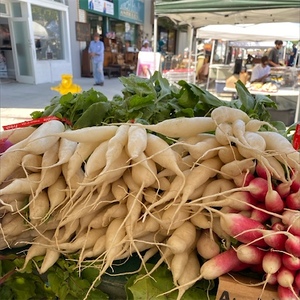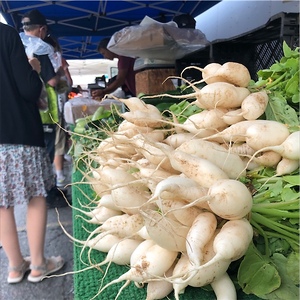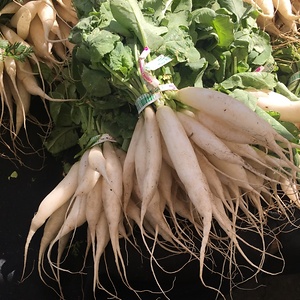


Icicle Radish
Estimated Inventory, 24 ct : 0
Description/Taste
Icicle radishes are elongated, slender roots, averaging 10 to 15 centimeters in length, and have a cylindrical shape tapering to a pointed root tip. The uniform roots have bright white, smooth, firm, and thin skin, sometimes found with a few taproot hairs extending from the bottom of the radish. Icicle radishes may also develop green shoulders when the top of the root is exposed above the soil and unprotected from sunlight. Underneath the skin, the flesh is dense, white, and aqueous with a crunchy, snap-like consistency. Icicle radishes have a succulent, crisp nature when raw and a mild, earthy, tangy, and peppery flavor. When the roots are cooked, the texture softens, becoming tender, and the piquant notes mellow, deepening into a neutral, sweet, and savory flavor. In addition to the roots, Icicle radishes also bear edible leafy greens that have a vegetal, grassy, and slightly pungent taste.
Seasons/Availability
Icicle radishes are typically available year-round in mild climates, with a peak season in the spring and summer.
Current Facts
Icicle radishes, botanically classified as Raphanus sativus, are heirloom radishes belonging to the Brassicaceae family. The fast-growing, long radishes reach maturity in approximately 23 to 30 days and are highly favored by gardeners for their easy-to-cultivate, heat tolerant, and pest resistant nature. The name Icicle radish is a general descriptor used for several varieties of slender, tapered white radishes, and the roots have also been known throughout history as White Naples, Icicle Short Top, White Italian, Lady Fingers, White Icicle, Long White, and White Transparent. Icicle radishes are not commonly grown for commercial markets, but they are a popular companion garden radish in home gardens when growing pumpkins and squash as the radish plants act as a natural deterrent of squash bugs. This specific variety of radish is also celebrated for its resistance to becoming pithy, as many other radishes tend to do with age.
Nutritional Value
Icicle radishes are an excellent source of vitamin C to strengthen the immune system, reduce inflammation, and guard the cells against free radical damage. The roots are also a good source of potassium to balance fluid levels and contain lower amounts of phosphorus and calcium to protect bones and teeth, copper, magnesium, iron, and folate.
Applications
Icicle radishes have a mildly sweet and peppery flavor well suited for raw, cooked, and pickled preparations. The radish can be eaten with or without the skin, and when raw, the flesh can be thinly sliced or grated into green salads. Icicle radishes can also be halved and served on appetizer plates with creamy dips, chopped and used as a topping over tacos, sliced and layered into sandwiches, or shredded as a condiment for sushi and sashimi. In addition to fresh preparations, Icicle radishes can be grilled, sauteed, roasted, steamed, braised, boiled, or stir-fried to develop a starchy texture similar to a potato. The flesh can be cooked with butter and sprinkled with salt as a simple side dish, roasted into chips, simmered in soups, curries, and stews, or braised as a savory vegetable. The radishes can also be pickled for extended use and consumed as a tangy condiment or snack. Beyond the roots, Icicle radish greens can be tossed into salads, stirred into soups, minced into dips, layered into sandwiches, or lightly cooked as a side dish. Icicle radishes pair well with meats such as poultry, turkey, beef, pork, and fish, bell peppers, snap peas, mushrooms, and herbs including dill, mint, coriander, parsley, and cilantro. Whole, Icicle radishes will keep up to one week when wrapped in plastic and stored in the refrigerator. Once cooked, the radishes will keep 3 to 7 days, and the leaves will keep up to 3 days in the fridge.
Ethnic/Cultural Info
In Europe, Icicle radishes were first cultivated in physics gardens, which were gardens developed for scientific research and study. Physics gardens date back to medieval times and primarily consisted of plants that contained medicinal value. Each garden was organized into sections distinguishing between plants that have known medicinal components and plants that were being studied for possible contributions, and the plants were grown to extract active ingredients that could be used to advance medicine and scientific studies. Over time, physics gardens were often established at universities, monasteries, apothecaries, and wealthy estates, and in 1447, even the Vatican had a medicinal garden that was used for botany education. Physics gardens eventually gave way to the modern botanical gardens, and today, there are several physics gardens still preserved at universities in England and Italy.
Geography/History
Icicle radishes are believed by experts to be native to Europe and were first documented in physics gardens in the 1600s, where they were studied for their medicinal applications. Much of the history of the heirloom radish is unknown before the 1600s, but the radishes were brought to the United States in the late 19th century. Several American seed catalogs listed the elongated white radishes in the early 21st century as a novel, home garden variety, and the roots were favored for their ability to be planted close together in compact spaces. Today Icicle radishes are grown worldwide and can be found through select farms, specialty distributors, and home gardens.
Recipe Ideas
Recipes that include Icicle Radish. One

















